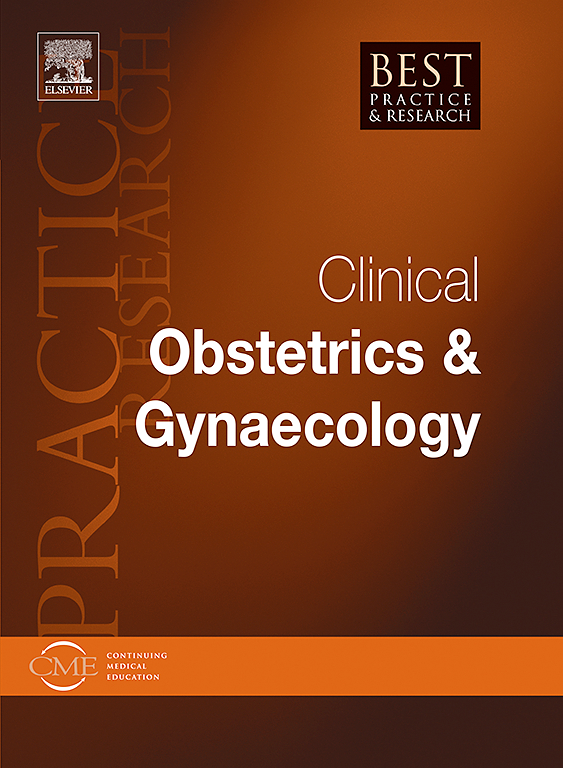Routine mid-gestational prediction of later preeclampsia
IF 4.1
2区 医学
Q1 OBSTETRICS & GYNECOLOGY
Best Practice & Research Clinical Obstetrics & Gynaecology
Pub Date : 2025-06-18
DOI:10.1016/j.bpobgyn.2025.102627
引用次数: 0
Abstract
Preeclampsia is thought to be superimposed upon cardiovascular and cardiometabolic risk factors, predominantly consistent with the metabolic syndrome. In this study, we developed and internally validated a prediction model for the development of later preeclampsia in pregnant women at routine second-trimester oral glucose tolerance testing.
Data were collected during a prospective clinical cohort study, including pregnant women undergoing routine gestational diabetes mellitus (GDM) screening. Routine clinical data during the GDM screening (e.g., oral glucose tolerance test) were considered as potential predictors. Univariable and multivariable logistic regression with Backward Wald elimination were performed to develop the prediction model. Internal validation was performed using bootstrapping. Predictive performance of the final model was evaluated in terms of discrimination and calibration, both before and after adjusting for overfitting.
Of 3227 pregnant women undergoing GDM screening, 137 (4.2 %) subsequently developed preeclampsia. The final prediction model included obstetric history of preeclampsia (yes/no), history of large for gestational age (yes/no), current antihypertensive drug use (yes/no), diastolic blood pressure (mmHg), fasting serum creatinine (μmol/l), fasting serum triglycerides (mmol/l), and urinary protein-creatinine ratio (g/mol creatinine). The area under the receiver operating characteristic curve of the model was 0.79 before and after internal validation, with good model calibration.
Upon external validation and impact analysis, the proposed second-trimester preeclampsia prediction model enables accurate estimation of individuals risk on predominantly later third trimester development of preeclampsia. The model could facilitate timely, tailored monitoring and early intervention among pregnant women at risk to improve pregnancy outcomes.
妊娠中期子痫前期的常规预测
先兆子痫被认为是叠加在心血管和心脏代谢危险因素上,主要与代谢综合征一致。在本研究中,我们开发并内部验证了妊娠中期常规口服糖耐量试验中孕妇晚期子痫前期发展的预测模型。在一项前瞻性临床队列研究中收集数据,包括接受常规妊娠糖尿病(GDM)筛查的孕妇。GDM筛查期间的常规临床数据(如口服糖耐量试验)被认为是潜在的预测因素。采用单变量和多变量logistic回归及后向Wald消去法建立预测模型。内部验证使用引导执行。最终模型的预测性能在判别和校准方面进行评估,在调整过拟合之前和之后。在3227名接受GDM筛查的孕妇中,137名(4.2%)随后出现先兆子痫。最终预测模型包括子痫前期产科史(是/否)、胎龄大病史(是/否)、当前降压药使用情况(是/否)、舒张压(mmHg)、空腹血清肌酐(μmol/l)、空腹血清甘油三酯(mmol/l)、尿蛋白-肌酐比值(g/mol肌酐)。内验证前后模型的受试者工作特征曲线下面积为0.79,模型标定良好。经外部验证和影响分析,提出的妊娠中期子痫前期预测模型能够准确估计个体在妊娠晚期主要发生子痫前期的风险。该模型可以促进对有风险的孕妇进行及时、有针对性的监测和早期干预,以改善妊娠结局。
本文章由计算机程序翻译,如有差异,请以英文原文为准。
求助全文
约1分钟内获得全文
求助全文
来源期刊
CiteScore
9.40
自引率
1.80%
发文量
113
审稿时长
54 days
期刊介绍:
In practical paperback format, each 200 page topic-based issue of Best Practice & Research Clinical Obstetrics & Gynaecology will provide a comprehensive review of current clinical practice and thinking within the specialties of obstetrics and gynaecology.
All chapters take the form of practical, evidence-based reviews that seek to address key clinical issues of diagnosis, treatment and patient management.
Each issue follows a problem-orientated approach that focuses on the key questions to be addressed, clearly defining what is known and not known. Management will be described in practical terms so that it can be applied to the individual patient.

 求助内容:
求助内容: 应助结果提醒方式:
应助结果提醒方式:


